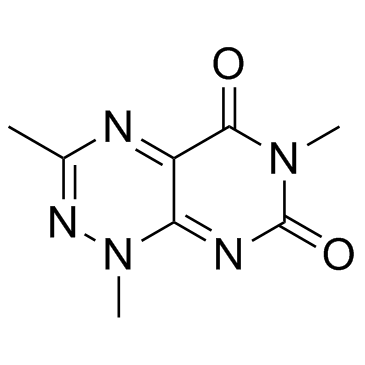32502-62-8
| Name | 1,3,6-trimethyl-1H-pyrimido[5,4-e][1,2,4]triazine-5,7-dione |
|---|---|
| Synonyms |
3-Methyltoxoflavin
3-Methyl-toxoflavin 1,3,6-TRIMETHYL-PYRIMIDO[5,4-E]-1,2,4-TRIAZINE-5,7(1H,6H)-DIONE 1,3,6-trimethylpyrimido[5,4-e][1,2,4]triazine-5,7(1H,6H)-dione 1.3.6-Trimethyl-5.7-dioxo-1.5.6.7-tetrahydro-pyrimido[5.4-e]as-triazin |
| Description | 3-Methyltoxoflavin is a potent Protein disulfide isomerase (PDI) inhibitor, with an IC50 of 170 nM. |
|---|---|
| Related Catalog | |
| Target |
IC50: 170 nM (PDI)[1]. |
| In Vitro | 3-Methyltoxoflavin is a potent Protein disulfide isomerase (PDI) inhibitor, with an IC50 of 170 nM. 3-Methyltoxoflavin is toxic in a panel of human glioblastoma cell lines. From the screen, 3-Methyltoxoflavin emerges as the most cytotoxic inhibitor of PDI. Bromouridine labeling and sequencing (Bru-seq) of nascent RNA reveals that 3-Methyltoxoflavin induces Nrf2 antioxidant response, ER stress response, and autophagy. Specifically, 3-Methyltoxoflavin upregulates heme oxygenase 1 and SLC7A11 transcription and protein expression and represses PDI target genes such as TXNIP and EGR1. Interestingly, 3-Methyltoxoflavin-induced cell death does not proceed via apoptosis or necrosis, but by a mixture of autophagy and ferroptosis[1]. |
| Cell Assay | The colon cancer cells are seeded in duplicate in 96-well plates at 7000-10000 cells per well. For the combination therapies, NAC is added to the well at the same time as 3-Methyltoxoflavin (35G8) (24 hours after plates are seeded), and Z-VAD-FMK and Necrostatin-1 are added to the well 1 hour prior to 3-Methyltoxoflavin addition. Cell growth inhibition is assessed by the cell viability rate. Cell viability is determined with the MTT assay. U87MG cells are seeded at 5000 cells per well in 96-well plates. Deferoxamine is added to cells in a five-point, three-fold dilution series from 400 μM. 3-Methyltoxoflavin is added immediately after in a five-point, three-fold dilution series from 100 μM. Cells are incubated with compounds for 12 hours[1]. |
| References |
| Molecular Formula | C8H9N5O2 |
|---|---|
| Molecular Weight | 207.18900 |
| Exact Mass | 207.07600 |
| PSA | 82.67000 |
| Storage condition | -20℃ |
